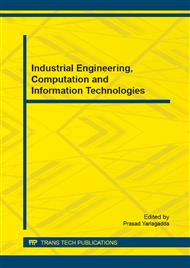[1]
Z. Guoqing and P. Zhongming, The application research of mobile robots and wireless sensor network in laser automatic guided vehicles, in 2011 International Conference on Measuring Technology and Mechatronics Automation (ICMTMA), 6-7 Jan. 2011, Los Alamitos, CA, USA, 2011, pp.708-11.
DOI: 10.1109/icmtma.2011.749
Google Scholar
[2]
L. Shiming, W. A. Gruver, D. Kotak, and S. Bardi, Holonic manufacturing system for distributed control of automated guided vehicles, in Systems, Man, and Cybernetics, 2000 IEEE International Conference on, 2000, pp.1727-1732 vol. 3.
DOI: 10.1109/icsmc.2000.886357
Google Scholar
[3]
R. D'Andrea and P. Wurman, Future challenges of coordinating hundreds of autonomous vehicles in distribution facilities, in Technologies for Practical Robot Applications, 2008. TePRA 2008. IEEE International Conference on, 2008, pp.80-83.
DOI: 10.1109/tepra.2008.4686677
Google Scholar
[4]
L. Oliveira, H. Li, L. Almeida, and T. E. Abrudan, RSSI-based relative localisation for mobile robots, Ad Hoc Networks, vol. 13, pp.321-335, (2014).
DOI: 10.1016/j.adhoc.2013.07.007
Google Scholar
[5]
W. K. Leow and M. H. Ang, Autonomic mobile sensor network with self-coordinated task allocation and execution, IEEE Transactions on Systems, Man and Cybernetics, Part C (Applications and Reviews), vol. 36, pp.315-327, (2006).
DOI: 10.1109/tsmcc.2006.871590
Google Scholar
[6]
I. F. Akyildiz and I. H. Kasimoglu, Wireless sensor and actor networks: research challenges, Ad Hoc Networks, vol. 2, pp.351-367, (2004).
DOI: 10.1016/j.adhoc.2004.04.003
Google Scholar
[7]
M. Rubenstein, C. Ahler, N. Hoff, A. Cabrera, and R. Nagpal, Kilobot: A low cost robot with scalable operations designed for collective behaviors, Robotics and Autonomous Systems, vol. 62, pp.966-975, (2014).
DOI: 10.1016/j.robot.2013.08.006
Google Scholar
[8]
S. Hossain, M. Y. Ali, H. Jamil, and M. Z. Haq, Automated guided vehicles for industrial logistics - Development of intelligent prototypes using appropriate technology, 2010 The 2nd International Conference on Computer and Automation Engineering (ICCAE), vol. 5, pp.237-241, (2010).
DOI: 10.1109/iccae.2010.5451466
Google Scholar
[9]
B. Y. A. Kelly, B. Nagy, D. Stager, and R. Unnikrishnan. (2007) An Infrastructure-Free Automated Guided Vehicle Based on Computer Vision.
Google Scholar
[10]
Y. Zhu, T. Zhang, J. Song, and X. Li, A hybrid navigation strategy for multiple mobile robots, Robotics and Computer-Integrated Manufacturing, vol. 29, pp.129-141, (2013).
DOI: 10.1016/j.rcim.2012.11.007
Google Scholar
[11]
P. R. Wurman, R. D'Andrea, and M. Mountz, Coordinating hundreds of cooperative, autonomous vehicles in warehouses, AI Magazine, vol. 29, pp.9-19, (2008).
Google Scholar
[12]
Y. Tan and Z. -y. Zheng, Research Advance in Swarm Robotics, Defence Technology, vol. 9, pp.18-39, (2013).
Google Scholar
[13]
A. Kamagaew, J. Stenzel, A. Nettstrater, and M. ten Hompel, Concept of Cellular Transport Systems in facility logistics, in 2011 5th International Conference on Automation, Robotics and Applications (ICARA 2011), 6-8 Dec. 2011, Piscataway, NJ, USA, 2011, pp.40-5.
DOI: 10.1109/icara.2011.6144853
Google Scholar
[14]
X. Wang, L. Ci, J. Li, and N. Yu, Based on PSO algorithm multiple task assignments for cooperating UAVs, in Educational and Information Technology (ICEIT), 2010 International Conference on, 2010, pp. V2-25-V2-28.
DOI: 10.1109/iceit.2010.5608449
Google Scholar
[15]
P. Feng, H. Xiaohui, R. Eberhart, and C. Yaobin, A new UAV assignment model based on PSO, in Swarm Intelligence Symposium, 2008. SIS 2008. IEEE, 2008, pp.1-7.
DOI: 10.1109/sis.2008.4668282
Google Scholar


